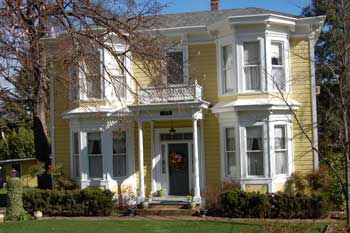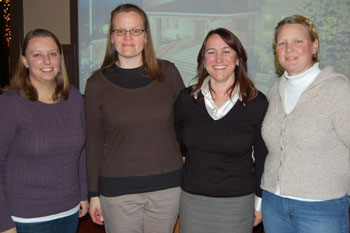The City’s National Historic Landmark District is reaching its own milestone; in the year 2016 our Landmark District will be 50 years old! This 50th anniversary should and will be celebrated; it is an honor to be a National Historic Landmark. Since becoming the Planning Director and Historic Preservation Officer for our City, I have learned that the citizens of Jacksonville care very much about our status as a Landmark District, but there are many misconceptions about what it means to be a District, where our District is, and who regulates what’s inside the District.
National Historic Landmarks are buildings, sites, districts, structures, and objects that have been determined by the Secretary of the Interior to be nationally significant in American history and culture.
National Historic Landmarks are also defined as exceptional places, and we can all agree that Jacksonville is an exceptional place. In 1966 the Jacksonville Historic District is listed as a National Historic Landmark (NHL) under the provisions of the Historic Sites Act of 1935, it is the first NHL listed in the state of Oregon.
All National Historic Landmarks are included in the National Register, under the auspices of the National Park Service (NPS), which is the official list of the nation’s historic properties worthy of preservation, with a total of roughly 85,000 listings. There are approximately 2,347 NHL’s comprising only 3% of listings on the National Register. The National Historic Landmarks Program does not manage or own National Historic Landmarks. It is up to us, the City and the Citizens of Jacksonville, to manage and preserve our District.
Our Landmark District is approximately 326 acres in size and includes some 688 structures. Our Landmark District Boundary is not the same as the City Limits, nor is it the Historic Core area; for an accurate depiction of the Landmark District Boundary please see the City’s Zoning Map available on our website. Since our first listing as a District, there have been three (3) inventories done to survey all of the properties within the District. These surveys were done in 1980, 1993 and 1999. The purpose of the inventory is to assess the resources within the District, and determine which properties are Contributing or Non-Contributing to the District. This is based upon the date of construction and the condition of the structure; does the structure still have integrity or has it been altered to a point that the structure is no longer contributing.
As I began regular correspondence with the State Historic Preservation Office (SHPO), the following were brought to my attention; (1) neither SHPO nor the National Park Service had ever received copies of the past three surveys and (2) the City had never established a “period of significance;” the period when the historic events associated with a proposed National Historic Landmark occurred. This period must reflect the dates associated with the property being nominated. A period of significance may be thousands of years (in the case of an archeological property), several years, or even a few days, depending on the duration of the event.
 The State Historic Preservation Office offered to conduct a new survey for the City of Jacksonville at no cost to us. The purpose was to (1) provide City officials and citizens of Jacksonville a fair and accurate assessment of resources within the District, (2) to document changes to buildings in the district over time, which will aid the city in regulating protected properties and in determining a period (or periods) of significance, and (3) to ensure that accurate, up-to-date data is available at the SHPO office in Salem, Oregon for future research and planning. Jacksonville’s resurvey was done this past fall from September 20-24, 2011. We received the results of the survey in December.
The State Historic Preservation Office offered to conduct a new survey for the City of Jacksonville at no cost to us. The purpose was to (1) provide City officials and citizens of Jacksonville a fair and accurate assessment of resources within the District, (2) to document changes to buildings in the district over time, which will aid the city in regulating protected properties and in determining a period (or periods) of significance, and (3) to ensure that accurate, up-to-date data is available at the SHPO office in Salem, Oregon for future research and planning. Jacksonville’s resurvey was done this past fall from September 20-24, 2011. We received the results of the survey in December.
The Jacksonville Historic District Resurvey contains 692 resources within the District boundary, of which there are 688 buildings, one cemetery (Jacksonville Cemetery), one park (Britt Park), one monument (the Methodist Episcopal Church Landmark) and one outdoor recreation site (Beekman Native Plant Arboretum). Within the district boundary, 224 structures out of 688, or 32.5%, were considered to be eligible/contributing to the district. The highest concentration of these buildings is found in the downtown area and California Street. For as large as our district is, this is a high percentage of eligible/contributing structures; a tribute to Jacksonville’s foresight and planning in becoming the first NHL in Oregon and being diligent about historic preservation.
Since there is no defined period of significance, all buildings built prior to 1965 with good integrity were counted as eligible/contributing. Good integrity means that the structure is still intact and has the same materials (original siding, windows, roofing), size (no small to large additions), and openings (no new doors or windows). A structure with two or more of these alterations was most often deemed non-contributing due to poor integrity. The most common alterations to historic buildings were window replacement (wood to vinyl) siding replacement (original wood siding to hardi-plank) and small to medium–sized additions. Approximately 137 structures, or 20%, were deemed non-contributing because of poor integrity. The large number of structures, 293 or 46%, were constructed less than 50 years ago and were considered not eligible/out of period.
The City of Jacksonville should continue to diligently preserve the 32.5% of structures that are considered eligible/contributing. This can be accomplished through education, design guidelines and application requirements required by the Land Development Code for remodels and new projects. The first step towards continued preservation is establishing a period of significance. The Historical and Architectural Review Commission (HARC) will be providing a recommendation to the City Council in the next few months. This will be based upon SHPO’s recommendation and input from citizens during public hearings. The City Council must adopt this period of significance by Ordinance during a public hearing. This period of significance will become part of our National Historic Landmark District acknowledged by both the National Park Service and SHPO. From this period of significance, the HARC will establish a new Landmark List of those structures that are eligible/contributing. This list will be based upon the SHPO survey, but will also be determined by other factors; for instance the home might not be considered contributing due to poor integrity, but a prominent citizen of Jacksonville may have lived there and therefore the City still considers the structure/site contributing. From this Landmark List new design guidelines and application requirements will be adopted in our upcoming Land Development Code Revision. The City hopes to have all of this completed in the next 12-18 months. That will give us time to focus on planning for our 50th Anniversary as a National Historic Landmark District in 2016!


Hello – I wondered if you could direct me to where I could obtain a listing of the 224 structures that are considered “eligible/contributing” to Jacksonville’s National Historic District. Normally I would like at the nomination form, but the NRHP website says that form has not yet been digitized. And the State Historic Sites Database lists most of the city’s addresses as “unknown” for contribution status. Thank you, Dan
I passed along your question to the City Planner…